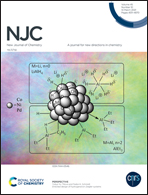Effect of poly(diallyldimethylammonium chloride) adsorption on the dispersion features of SiC particles in aqueous media
Abstract
Silicon carbide (SiC) is widely used as an advanced ceramic material, but the dispersion of concentrated SiC suspension is difficult. In this work, poly(diallyldimethylammonium chloride) (PDADMAC) was used as a dispersant to obtain a concentrated SiC suspension with low viscosity. The interaction between PDADMAC and the SiC surface was studied by adsorption measurements at three pH values. The results indicated that PDADMAC had a high adsorption affinity to the SiC surface. The adsorption capacity of PDADMAC increased as the pH increased and achieved the maximum value of about 4.355 mg g−1. X-ray photoelectron spectroscopy (XPS) measurements confirmed that 27.67% of SiO2 existed in the SiC powder surface and PDADMAC was successfully adsorbed on its surface. The dispersion behavior of SiC powders in water was studied by zeta potential and sedimentation measurements. PDADMAC modified SiC powders became positively charged in the pH range from 2 to 11.6 and a SiC suspension with high stability was obtained at pH 3 through an electrosteric stabilization mechanism. The 54 vol% SiC suspension with a viscosity of 0.539 Pa s was suitable for slip casting. Finally, the SiC green body with a high relative density (70.14%) was prepared.



 Please wait while we load your content...
Please wait while we load your content...